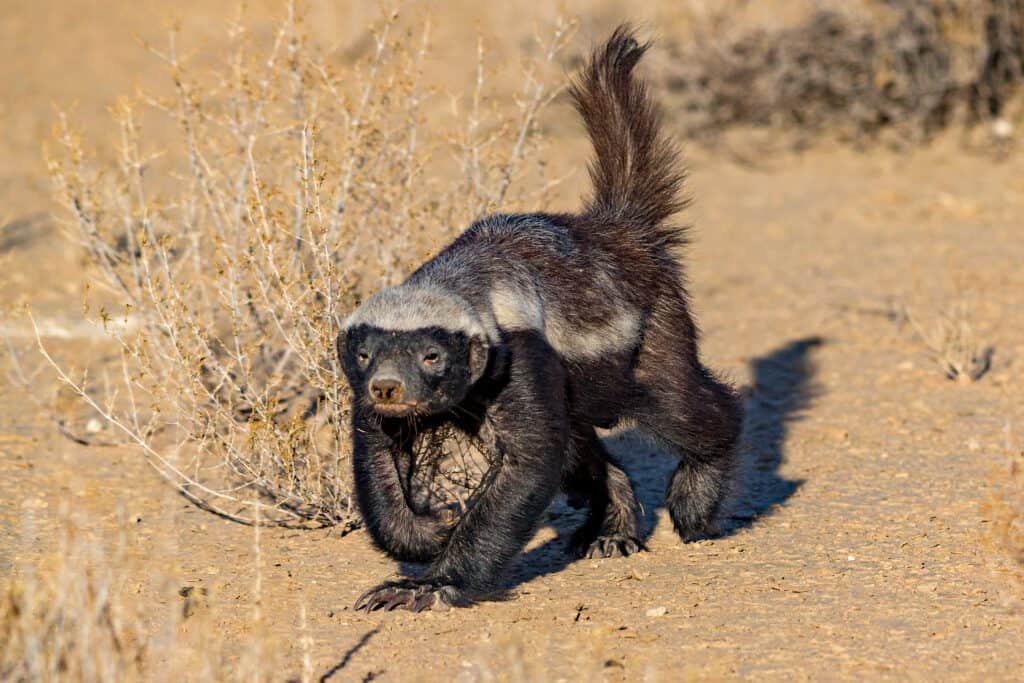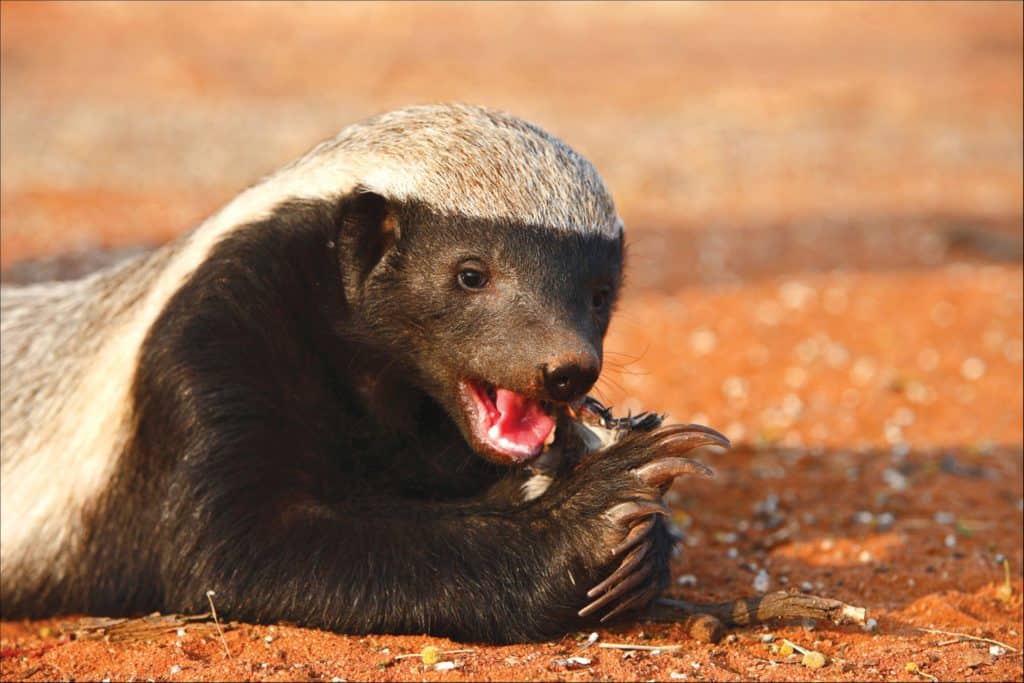It’s finally time to find out who wins in a king cobra vs. honey badger battle!
The king cobra is one of the longest snakes alive, and they have a nasty bite. The venom is potent enough to kill 11 humans or more.
The honey badger also has a killer mindset. This digging machine has a sturdy body, long claws, sharp teeth, and powerful jaws. They use their razor claws to plow the soil and snatch prey out of their burrows.
Honey badgers never back down from a fight. So, it will be game on when the king cobra threatens this aggressive creature. Who will win the battle? Let’s find out!
King Cobra

Their upright posture gives them the top advantage when delivering venomous bites.
©iStock.com/takeo1775
Displaying sharp fangs as it lifts its body off the ground, the king cobra slithers into the ring. King cobras have a home range from India to Indonesia. When threatened, this powerful snake can raise its body 4 feet off the ground as it chases its opponent. The upright posture also gives them the top advantage when delivering venomous bites. The neurotoxin contains 73 amino acids and 5 disulfides. A single bite is enough to kill a full-grown elephant!
Honey Badger

This competitor has sharp claws and strong jaws; they’re always ready to fight!
©Braam Collins/Shutterstock.com
Dancing around the snake while emitting a smelly musk is our second competitor, the honey badger. Honey badgers have poor eyesight but a great sense of hearing and smell. This 40-pound contender can reach speeds of over 30 mph and has a reputation for being one of the most formidable foes in the animal kingdom. This competitor has sharp claws and strong jaws; they’re always ready to fight!
King Cobra Vs. Honey Badger: Comparison Chart
| Animal Battle Factors | King Cobra | Honey Badger |
|---|---|---|
| Size | 10 to 15 pounds 10 to 19 feet long | 2.5 feet long 1 foot tall 40 pounds |
| Speed | 5 mph | 19-35 mph |
| Characteristics | Non-aggressive behavior (flees) Paralyzes prey with neurotoxin Mainly eats other snakes | Gallops when running full speed Aggressive nature Can scare off lions Eats scorpions and snakes Preys on venomous snakes |
| Top Advantages | Excellent camouflage Venom can kill an elephant Neurotoxic venom Upright fighting posture Well-placed strikes .5-inch long fangs Ability to hide in small places Aposematism | Fierce attitude Overpowering musk Razor sharp claws Powerful teeth Bone crushing jaw Tough skin Can turn around in skin |
The king cobra vs. honey badger battle will compare the animal’s size, speed, attack abilities, and defenses. The king cobra is much longer than the honey badger but weighs much less. And each of these creatures has different ways of attacking and evading threats.
One of the biggest arguments for this animal matchup is that the honey badger is resistant to venom. And that’s true! But if the king cobra can land multiple bites, the increased neurotoxin just might be enough to take down the wild honey badger. Let’s see how the battle begins as we kick off round one!
Round One: Size And Speed
Round one is all about size and speed. Which animal competitor will have the weight and agility to take home the trophy? Let’s start by looking at the king cobras’ stats.
The king cobra can grow between 10 to 19 feet long. On average, they weigh 10 to 15 pounds. This is incredibly large for a snake.
As mammals go, the honey badger has an average size. Honey badgers weigh around 40 pounds and grow between 2 to 2.5 feet long.
Speed is where the honey badger will shine in this round. These aggressive creatures can run at speeds of 19 to 35 mph. They often gallop toward their prey. The king cobra doesn’t stand a chance of outrunning the speedy honey badger.
King cobras have an average speed of 1 mph but can go as fast as 5 mph. The snake won’t be able to escape fast enough, but it could attack with enough force to gain an advantage. The king cobra has a striking speed of nearly 3 meters per second squared. They strike fast and aim to kill.
Round Two: Attack Abilities
Both creatures are savvy predators who know how to find all sorts of tasty creature meals. But they go about finding and killing their prey in very different ways.
The king cobra is a stealthy ambush predator. Despite their large size, they can slither into small spaces where they hide, waiting for prey.
What do they eat? Cold-blooded animals, especially other snakes, make up the king cobra’s diet. Some of their favorite snakes to eat include the Asian rat snakes and 10-foot-long pythons. They’re also cannibalistic and will eat smaller king cobras.
The king cobra relies on its bite to take down prey. They use a neurotoxic venom to strike vital places such as the chest, head, or neck. Using fangs that measure 5 inches, they deliver up to 500 mg of deadly neurotoxin with every bite. And the king cobra is an expert in striking with accuracy. They’ve been known to land bites on agile mongooses.
The honey badger is an expert at delivering well-placed bites that can splinter bones and crack open a tortoiseshell with a single chomp! These mustelids also have 1.5-inch-long claws for digging and slashing enemies. They also use their great sense of smell to locate prey and dig them out of their burrows.
Round Three: Defenses
We’ve come to the end of our king cobra vs. honey badger battle. Round three will determine who’s worthy of taking home the crown.
The king cobra has aposematism, markings that let other animals know they are venomous snakes. But they will need more than that to help them in this animal battle. Honey badgers have evolved to survive venomous bites, so the cobra’s neurotoxin isn’t going to send them running. Instead, the king cobra will have to intimidate the honey badger using its body language and vocalizations.
The 19-foot-long king cobra can lift its body off the ground to intimidate its opponent. Raised off the ground, they also have the advantage of making the most well-placed strikes. These snakes also know how to wait it out as the venom kicks in.
The king cobra is known to envenomate prey and leave the crime scene. After the venom has taken effect, the king cobra will return to enjoy its freshly killed meal.
The honey badger will have a stinky response to the king cobras threats. These mammals can emit a disgusting musk that overpowers predators. The stench is enough to choke their opponent and send them running for fresh air.
What happens if the king cobra bites the honey badger? It could be a deadly mistake for the snake. Honey badgers can wiggle around in their skin!
When the snake lands a bite, the honey badger can whip around and return fire with its sharp claws and teeth. And remember, the honey badger is resistant to venom. Later, they’ll sleep off the nasty effects and wake up to live another day.
Who Is The Champion?

The honey badger outmatches the king cobra regarding speed, defense, and attack abilities.
©Erwin Niemand/Shutterstock.com
The honey badger is the champion of this king cobra vs. honey badger animal battle! The king cobra was at an instant disadvantage against an opponent that could resist venom. When you add the honey badger’s ability to whip around in its skin to return the attack, the snake never stood a chance.
The king cobra is an impressively long, venomous snake. They can take down all sorts of cold-blooded animals, but they’re not taking home the trophy in this animal match-up.
The honey badger outmatches the king cobra regarding speed, defense, and attack abilities. It was an intense battle with many bites and strikes, but the honey badger remains standing.
The photo featured at the top of this post is ©
Thank you for reading! Have some feedback for us? Contact the AZ Animals editorial team.






